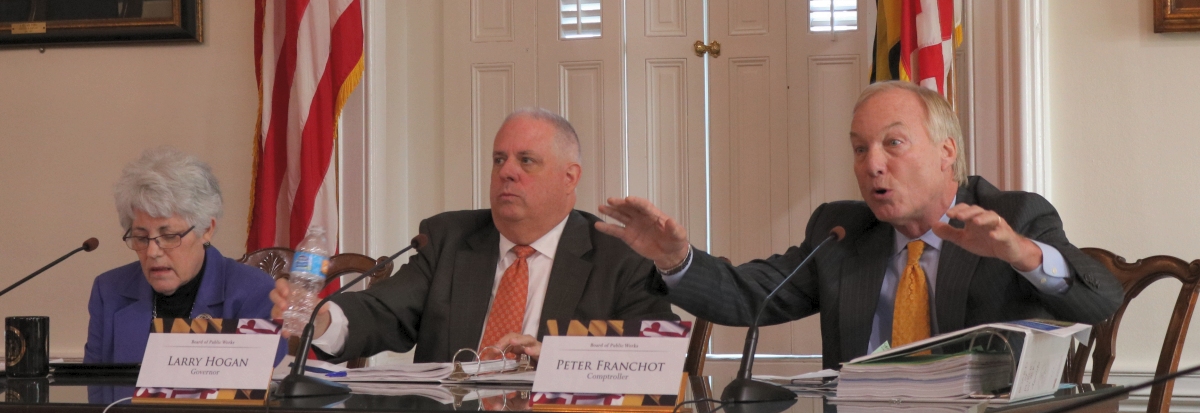ANNAPOLIS (Nov. 3, 2016)—The Maryland Board of Public Works voted unanimously in favor of $82 million in cuts to state spending Wednesday in Annapolis.
Republican Gov. Larry Hogan and Democratic board members Comptroller Peter Franchot and Treasurer Nancy Kopp agreed on the issue after the Maryland Board of Revenue Estimates predicted last month that revenues for the current fiscal year would be $365 million less than expected.
The biggest cuts are expected to take place in the University System of Maryland, the Department of Health and Mental Hygiene, and the Department of Juvenile Services.
The University System of Maryland's budget was reduced by $18.2 million, including $11.5 million from 100 cut positions—41 filled and 60 vacant.
The reductions trim $20.8 million from the Department of Health and Mental Hygiene, but $20 million will be covered by the Cigarette Restitution Fund, money received from a 1998 settlement with the tobacco industry.
The Department of Juvenile Services is facing $9.1 million in reductions.
Audra Harrison, a spokeswoman for the Department of Juvenile Services, said the new budget should not affect their operations.
"Because there are fewer youth in the juvenile system today, the department can absorb the reductions with no impact to public safety nor to services for youth."
Franchot said that while these trims will make a difference, they are not as large as past cutbacks.
"This is a very modest cut compared to what we did in the previous administration, where we cut over $2 billion, (over) 10 or 11 different occasions," he said. "That's a huge difference than what we did today."
David Brinkley, secretary of the Department of Budget and Management, stressed departments are still receiving increases in spending over the previous fiscal year, just less than originally anticipated.
"What we are doing is restricting some of the spending based on lower estimated usage," he told the University of Maryland's Capital News Service.
Last month, officials said Maryland's revenue estimate shortfall is due largely in part to the state's concentrated job growth in low-wage positions. The budget relies heavily on the state's revenues.
"We are creating jobs that are highly concentrated in industries that pay below state average," Andrew M. Schaufele, director of the Bureau of Revenue Estimates, said last month.
Brinkley said budget restrictions came out now to give departments the most time to adapt to them with eight months left in the fiscal year.
"Our expectation is by doing this early, the departments themselves can integrate into the reduced increases and not have any interruptions of services."
Hogan pointed to Maryland's Democrat-controlled legislature for the state's monetary issues.
"Unfortunately, due to unsustainable forced increases in spending, the state has simply been spending more than it takes in," Hogan said. "Even the legislature's own budget officer, Warren Deschenaux, is raising serious concerns."
Last week, Deschenaux spoke at the Department of Legislative Services' Spending Affordability Briefing to members of Maryland's General Assembly. He urged state lawmakers to be realistic in spending in order to help stop a recurring budget gap.
"How much we pay for things is within our discretion to some extent, how we structure our programs is in our control," Deschenaux said.
Kopp on Wednesday pointed out that the budget the legislature passed was "structurally balanced."
"I wouldn't want folks to think that the budget was passed in deficit or that the problem we face today at the moment is due to excess spending," Kopp said.
"The revenue estimates came in low," she said about the $365 million—or 2 percent—cut in the revenue estimates prediction from last month. "A small percentage in a very large budget is a good amount of money." Maryland's fiscal 2017 operating budget was $17.1 billion.
Hogan is expected to present his 2018 fiscal year budget in January.
Md. Board Approves $82 Million Cut in State Spending

The Board of Public Works members Treasurer Nancy Kopp, Gov. Larry Hogan and Comptroller Peter Franchot discuss Maryland's cuts in spending for the 2017 fiscal year on Wednesday, Nov. 2, 2016. (Photo: Vickie Connor)


